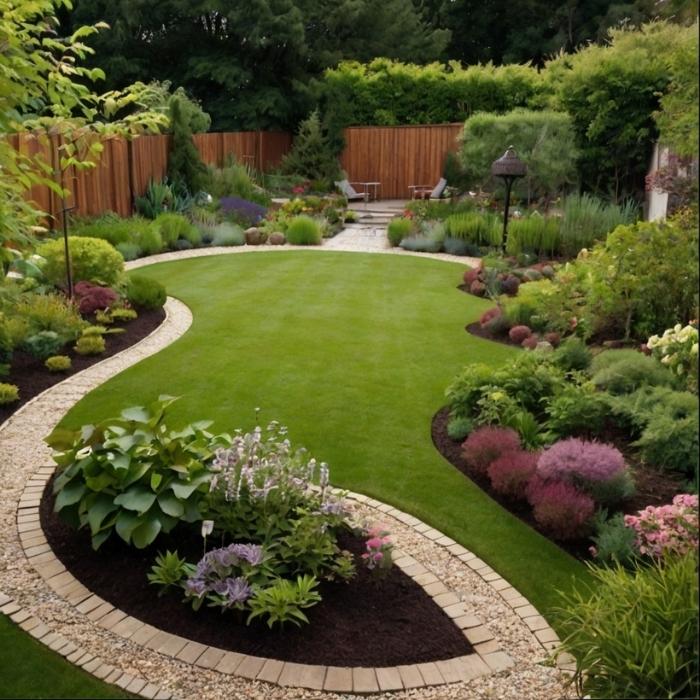Garden Design Ideas: Transform Your Outdoor Space into a Blissful Retreat
Your garden is an extension of your home—a place to relax, entertain, and connect with nature. Whether you have a small backyard, a sprawling outdoor area, or even just a patio, the right design can transform your space into a stunning retreat. In this blog, we’ll explore creative garden design ideas that suit various spaces, preferences, and budgets.
1. Plan with Purpose
Before diving into any Garden design ideas, it’s essential to think about the purpose of your outdoor space. Do you want a tranquil haven for relaxation, an area for entertaining guests, or a family-friendly yard where kids can play?
Start by sketching your garden’s layout. Divide it into zones for specific functions, such as dining, lounging, or planting. Use natural boundaries like shrubs or hedges to separate areas while maintaining an open, cohesive look.
A well-thought-out plan will ensure every square foot of your garden serves a purpose and works harmoniously with the rest of your home.
2. Play with Layers
Adding layers to your garden design creates depth and visual interest. Think of your garden as a canvas—combine tall trees and shrubs for the backdrop, medium-sized plants for the mid-layer, and colorful flowers or ground cover for the foreground.
For a more dynamic effect, incorporate climbing plants like ivy or wisteria to create vertical interest. A trellis, pergola, or arbor can serve as both a decorative element and a support for these plants, adding a romantic touch to your space.
3. Embrace Low-Maintenance Landscaping
If you want a stunning garden without spending hours on upkeep, low-maintenance landscaping is the way to go. Opt for drought-tolerant plants like succulents, lavender, or ornamental grasses. These not only thrive in various climates but also require minimal watering.
Consider using mulch or gravel to cover exposed soil, as this reduces weed growth and retains moisture. Installing an automated irrigation system can further simplify maintenance while keeping your garden lush and green.
4. Incorporate Outdoor Living Spaces
Your garden can double as an outdoor living area with the right design. Add a deck or patio with comfortable seating to create a space for dining, lounging, or hosting gatherings.
Use weather-resistant furniture, cozy cushions, and an outdoor rug to make the area feel inviting. For colder evenings, consider adding a fire pit or patio heater. String lights or solar-powered lanterns can add ambiance, making the space functional day and night.
5. Design with Color and Texture
The right combination of colors and textures can elevate your garden from ordinary to extraordinary. Choose a color palette that complements your home’s exterior. For a calming vibe, stick to cool tones like blues and purples. If you prefer something more vibrant, go for bold reds, oranges, and yellows.
Mix different plant textures to create contrast. Pair feathery grasses with broad-leafed plants or smooth succulents with spiky flowers. This interplay of textures adds depth and intrigue to your garden.
6. Add Water Features
Nothing enhances a garden’s tranquility like the soothing sound of flowing water. A small pond, fountain, or waterfall can become the focal point of your outdoor space.
For smaller gardens, consider a tabletop fountain or a wall-mounted water feature. These options take up minimal space but still offer the calming effects of water.
If you’re feeling adventurous, install a natural swimming pool. It’s an eco-friendly option that combines aesthetics with functionality, giving you a unique feature to enjoy.
7. Create Wildlife-Friendly Spaces
Invite birds, bees, and butterflies into your garden by designing with wildlife in mind. Plant native species and flowers rich in nectar to attract pollinators. Adding a birdbath or birdhouse can make your garden a haven for feathered friends.
Hedgehog houses, log piles, or a small wildflower meadow are great ways to support local wildlife. Not only does this add life to your garden, but it also promotes biodiversity and enhances your connection to nature.
8. Use Pathways to Guide the Eye
Pathways serve both a functional and aesthetic purpose in garden design. They guide visitors through the space while adding structure and charm.
Use materials like gravel, stone, or brick to create pathways that match your garden’s style. For a whimsical look, consider curved paths that lead to hidden nooks or focal points. Line the edges with low-growing plants or solar-powered lights for added definition.
9. Blend Functionality with Beauty
Practical features like raised garden beds or vertical planters can be both functional and visually appealing. Raised beds are perfect for growing vegetables, herbs, or flowers, while vertical planters maximize space in smaller gardens.
You can also integrate storage solutions like benches with built-in compartments or stylish garden sheds that blend seamlessly with your design. This ensures your space remains clutter-free while maintaining its aesthetic appeal.
10. Personalize Your Garden
Make your garden truly yours by adding personal touches. Incorporate elements that reflect your style and personality, whether it’s whimsical garden ornaments, handcrafted furniture, or a custom mural on a garden wall.
DIY projects like painted pots, upcycled furniture, or handmade stepping stones can add a unique charm. The key is to create a space that feels like an extension of yourself.
11. Consider Lighting
Outdoor lighting transforms your garden at night, creating a magical atmosphere. Use different types of lighting to highlight features, add ambiance, and ensure safety.
Spotlights can illuminate trees or sculptures, while string lights add a festive touch. Solar-powered stake lights are an eco-friendly option for pathways, and LED strips can be used to define seating areas or steps.
12. Think Seasonally
A garden that looks great year-round requires careful planning. Choose a mix of plants that bloom in different seasons to ensure your garden remains vibrant no matter the time of year.
For winter interest, consider evergreens, ornamental grasses, or trees with interesting bark, like birches. Spring bulbs, summer perennials, and autumn foliage will keep your garden colorful throughout the year.
Final Thoughts
Designing your garden is a rewarding journey that allows you to express creativity and enjoy the beauty of nature. With the right planning, thoughtful details, and a mix of functionality and aesthetics, you can create an outdoor space that suits your lifestyle and brings joy for years to come.
Start small, experiment with Garden design ideas , and let your garden evolve over time. Whether you’re going for a modern minimalist vibe or a lush cottage garden, the possibilities are endless. Cozy Outdoor Living Ideas for Your Perfect Retreat

